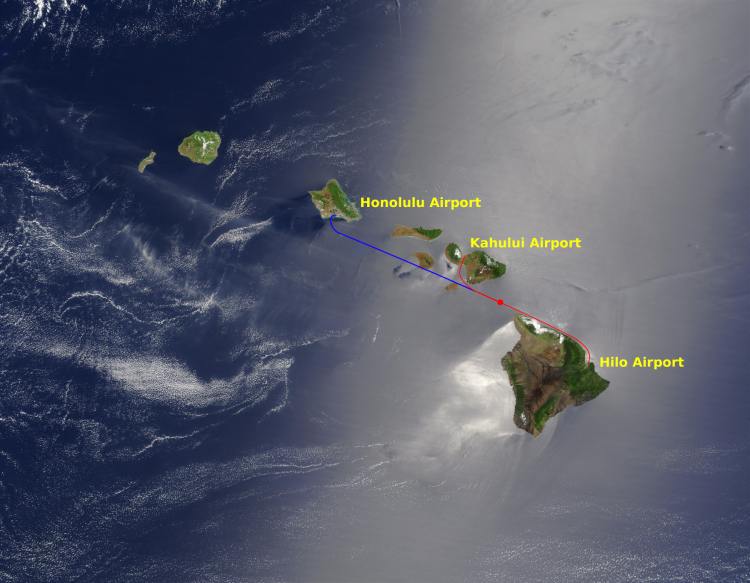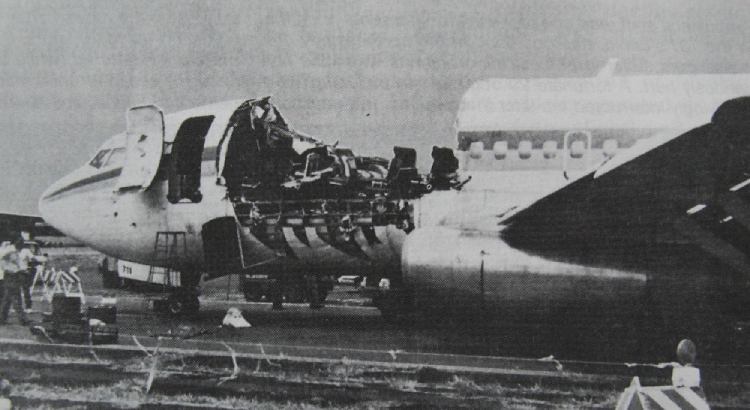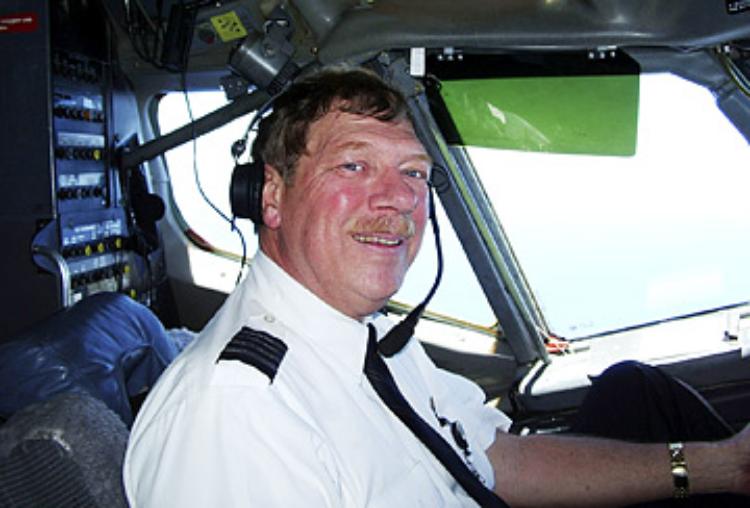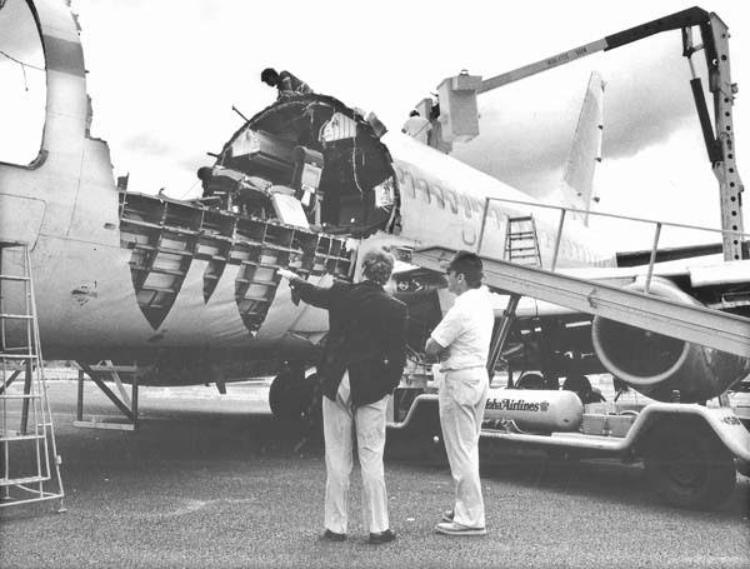Aloha Airlines Flight 243 Lost Its Roof at 24,000 Ft., But Landed Safely

It was just a 35-minute journey from Hilo to Honolulu for all 95 passengers and crew of Aloha Airlines Flight 243. But who would have guessed that their worst fears would come true on this seemingly ordinary day? How would it so quickly turn into a nightmare?
While cruising at 24,000 ft, a section of the airplane’s roof suddenly ripped off, exposing the passengers to the sky amidst flowing debris, hanging wires, and unbearable cold blasts! In a split second, their lives hung by a thread. But surprisingly, this nightmare has a happy ending! Aloha Airlines Flight 243 landed safely and is still remembered as one of the most miraculous landings in the history of aviation!
Table of Contents
What happened on Aloha Airlines Flight 243?
https://twitter.com/AirCrashMayday/status/725697423142739969
It was a bright, sunny day on April 28, 1988, when Flight 243 departed Hilo. The pre-departure inspection was routine, and nothing unusual was detected. About 20 minutes into the flight, the plane reached an altitude of 24,000 feet ( 7,315 meters). Suddenly there was a whooshing sound due to a massive, explosive decompression. A portion of the fuselage tore open, causing a large section of the roof to rip apart! This 18-f00t gaping hole consisted of the entire top half of the aircraft skin extending from just behind the cockpit to the fore-wing area. The cockpit door broke away, exposing passengers to the sky, where the first-class ceiling had been.
The cabin was depressurized with no emergency oxygen supply, with freezing temperatures of almost -50 C ( -58 F) and winds three times hurricane force. Unless they reached a lower altitude, all passengers would soon die. The pilot, not fully aware of what was happening behind him, immediately began an emergency descent toward the nearest airport on Maui. It was probably the toughest, scariest 13 minutes in the lives of everyone on board. The flight landed safely, though both the engines had failed by then. The aircraft was severely damaged and beyond repair. The part of the fuselage that was blown off was never recovered. One flight attendant lost her life due to the incident, but the fact that the plane could land with all passengers safe was nothing short of a miracle.
Flight attendant Clarabelle Ho Lansing lost her life in the accident.
Flight attendant Clarabelle Ho Lansing was with Aloha Airlines for 37 years and was the chief flight attendant on Flight 243. When the accident occurred, she was standing in the aisle at Row 5 in the first-class seats, handing out drinks to the passengers. As soon as the roof ripped off, she was sucked out of the airplane in a matter of a few seconds.
According to passenger William Flanigan, “She was just handing my wife a drink. She stopped and told us this was the last call. We were going to be descending, and then, whoosh! She was gone. Their hands just touched when it happened.”

The Coast Guard from Maui did an extensive search in the waters between Maui and Oahu for three days, along with helicopters from Barber’s Point Coast Guard Air Station on Oahu, looking for the missing flight attendant and debris from the aircraft. However, her body was never found.
The pilots of the ill-fated Flight 243 heard a loud BANG! at 24,000 feet.

What was happening in the cockpit of the plane? The captain of the ill-fated flight was Robert Schornstheimer, an experienced pilot with 8,500 flight hours, most of them being Boeing 737s. First Officer Madeline “Mimi” Tompkins also had significant experience flying the 737s. Tomkins made the takeoff and reached 24,000 feet (7,315 meters) without any incident. Suddenly, the pilots heard a loud bang as they lost control and felt exposed air. Without any knowledge of exactly what happened, they knew they had to descend the plane.
Schornstheimer steered the plane gently toward the nearest airport on Maui. Communication with the air traffic control in Honolulu was proving difficult, so Mimi Tompkins switched to the Maui tower. She managed to communicate the urgent need for ambulances. Both pilots had absolutely no idea what was going on behind the cockpit. They could not communicate with the flight crew and had to focus on flying to keep alive any chances of survival. After 13 minutes, the pilots landed the plane manually at Kahului Airport on Maui. Even then, they did not know the extent of the damage behind them.
The safe landing of Flight 243 is considered a miracle in aviation history!

In Captain Schornstheimer’s words, he could see “…blue sky where the first-class ceiling had been.” As soon as the accident occurred, he took control of the aircraft, deployed the flaps, and descended at a rate as high as 4,100 feet per minute (20.83 meters per second). The nearest airport was Kahului Airport on the island of Maui, and Schornstheimer steered the plane in that direction with “loose” and “sluggish” flight controls.

The captain and the first officer showed brilliant teamwork, resolve, and skill in the face of this impending danger. Captain Mimi Tompkins assisted the captain and handled the communications. Schornstheimer slowed the airline as it descended through 10,000 feet (3,048 meters) and maintained the speed required to keep the airliner in control for approaching the runway. When they lowered the landing gear, the green light indicated the nose gear did not work, and the manual system was activated. But despite the lights not working, the captain knew there was no time to troubleshoot. At this point, the number one engine had failed. The pilot used the thrust reverser of the second engine to slow the airplane. The plane landed safely. As soon as it rolled to a stop, the emergency evacuation started. Everyone knew they were alive because of the pilots.
This accident changed the entire future of aviation safety rules.

The incident on Flight 243 was an eye-opener for the aviation industry. How does the roof of a jet airliner simply blow away? As per the investigation by NTSB (National Transportation Safety Board), the cause of this accident was stated as explosive decompression caused by metal fatigue in the aircraft’s structure, specifically in the lap joint of the forward fuselage, and maintenance error.
The investigation revealed that this 19-year-old plane was designed for a 20-year service life and 75,000 flights. But this particular aircraft had exceeded the number of flights way beyond what it was designed for. As a result, its fuselage was under constant stress due to pressurization. As per the investigation, corrosion was another reason the accident occurred. Corrosion is a common occurrence in flights that operate in a coastal environment, with exposure to salt and humidity. But NTSB’s final report concluded that maintenance was deficient, and instead of grounding airplanes for a detailed nose-to-tail examination, occasional inspections were done often at night under artificial lights, due to which tiny cracks escape inspection.
This accident brought to the forefront an unrecognized problem of the continuing airworthiness of an aging aircraft. After the accident, the FAA addressed the issue of how long planes should fly, and the National Aging Aircraft Research program was created. It monitors the structural integrity of older planes. This further led to significant changes in the inspection and maintenance procedures for all aircraft to prevent such accidents in the future.
The Aloha Airlines Flight 243 serves as a reminder of the importance of safety measures and precautions in the aviation industry. On that fateful day, the only phrase on everyone’s mind was, “Thank you, Captain!”
























